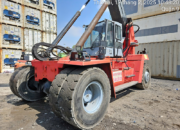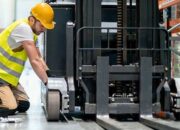Common failures in Diesel forklifts and remedies
Diesel forklifts have mechanical failures during operation, which can damage fundamental components and cause more serious problems for the vehicle, goods, and people. Usually before diesel forklifts have problems. Factors such as: speed, sound, exhaust gas, water temperature, oil pressure and other related problems of it will all show some abnormality, which is characteristic of signs of failure. crash before. Therefore, Samcovina.com would like to list the common mistakes people make when managing operations, thereby quickly making accurate judgments based on the characteristics of the omens, thereby making judgments and giving solutions. measures to avoid accidents.
reachtruck
Forklift jumping.
Error of sudden acceleration, faster and faster, unable to control the accelerator pedal, abnormally harsh sound, the exhaust pipe emits a lot of blue or black smoke.
“Jumping diesel forklift” is idling over speed, does not occur when working under load, but only occurs when the load suddenly disappears or decreases slightly immediately after starting or during work. The main cause is a faulty governor system that leads to loss of control of the oil supply or the oil tank due to too much oil. Warning about the phenomenon of “Jumping diesel forklift”, if urgent measures are not taken immediately, it will eventually lead to major accidents such as cylinder knocking, shaft breakage.
Remedy: mainly to achieve a temporary purpose by cutting off oil or gas. The emergency measures that can be taken are: first, turn off the throttle to limit fuel supply and apply the brake; second, block the intake manifold and cut off the air passage; third, quickly loosen the high-pressure fuel pipeline to stop the fuel supply; fourth, using the vehicle’s diesel engine when running heavy loads (braking) is high, causing the engine to stall due to insufficient torque.
Doll error in diesel forklift
When the speed is reduced, the vehicle is weak, the sound is abnormal, the water temperature is high, and the water temperature meter indicator exceeds 100 ℃. At this point, sprinkle some water on the machine, it will quickly evaporate. The main reason is that the machine is seriously lack of water and the water cooling system is damaged. If the engine stops immediately, stalling may occur.
Remedy for diesel forklift engine: idling for a period of time or turning off the cooling assist crankshaft to lower the water temperature to about 40 °C, then slowly add the coolant. Pay attention not to add cooling water immediately, otherwise it will cause the parts to be deformed, cracked due to the sudden drop in local temperature.
Cylinder insertion error in Diesel forklift engine
There is a “click” in the crankcase, like a small hammer hitting a hard floor, commonly known as a “cylinder knock”. Oil pressure decreases and becomes more pronounced during rapid acceleration.
Cylinder insert is destructive mechanical damage, mainly caused by loose connecting rod bolt or tensioning neck of the bolt, the gap between the connecting rod shafts is too large, causing the bolt to loose or break. If there is a knock but the oil pressure is normal, it is not a sign of cylinder knocking, it should be considered from the perspective of adjusting the fuel supply angle.
Remedy: Shutdown immediately for service and replace with new parts.
Damaged bearings in Diesel forklifts
When making a gurgling sound, there seems to be a sudden increase in load, a decrease in speed, a decrease in oil pressure, a black smoke discharge. Burned bushing will cause the bearing bush and bearing to lock and freeze
The main reason is that the lubricating oil film on the bearing surface is destroyed, the bearing bush and the bearing surface metal are in direct contact with each other, the friction temperature rises rapidly, and glue appears.
Remedy: stop the machine immediately, remove the cover and check the connecting rod and bearing bush, find the cause, repair and replace.
Shaft failure in diesel forklift
When there is an unusual knock in the crankcase, when accelerating, the knock becomes louder, the components vibrate strongly when idling and the exhaust pipe emits black smoke. Shaft fracture is caused by mechanical weakness in the shoulder of the crankshaft, and there is a gradual process from cracking to fracture. In recessive fission, the characteristics of the phenomenon are not clear, as the crack expands, the features of the harbinger become more and more obvious, and eventually cause the broken shaft to stall. If the throttle is shaky or the knocking frequency is the same, it may have reached the critical point of shaft breakage. At this time, remove the cover and check, push the flywheel by hand, if the shaft clearance is large and the push is not difficult, the crankshaft is damaged.
cho thuê xe nâng, xe nâng






